Click on images to enlarge
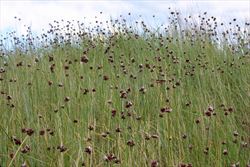
large infestation (Photo: Trevor James)
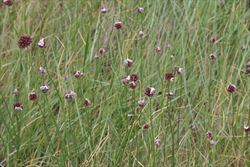
habit growing in a grassland (Photo: Trevor James)
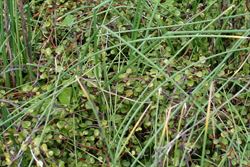
leaves (Photo: Trevor James)
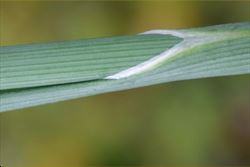
close-up of leaf base and stem, showing the leaf sheath (Photo: Trevor James)
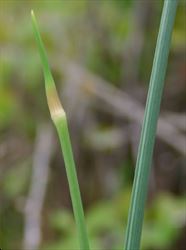
a flower bud and leaf (Photo: Trevor James)
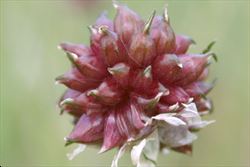
cluster of bulbils and remains of papery bract (Photo: Trevor James)
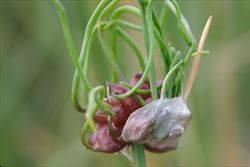
the bulbils sometimes have green leaf-like bracts between them (Photo: Trevor James)
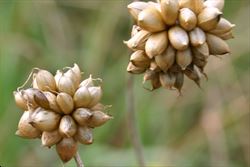
mature bulbils (Photo: Trevor James)
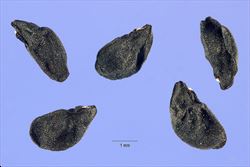
close-up of seeds (Photo: Steve Hurst at USDA PLANTS Database)
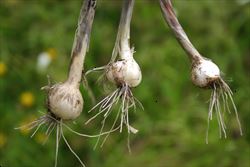
bulbs (Photo: Trevor James)
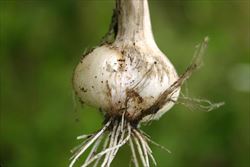
close-up of a bulb (Photo: Trevor James)
Scientific Name
Allium vineale L.
Synonyms
Allium vineale L. var. compactum (Thuill.) Lej.
Family
Alliaceae (Queensland, New South Wales, the ACT and Western Australia)Liliaceae (Victoria, Tasmania and South Australia)
Common Names
crow garlic, false garlic, field garlic, scallions, stag garlic, stag's garlic, wild garlic, wild onion
Origin
Native to north-western Africa (i.e. Algeria and Morocco), the Canary Islands, Europe and western Asia (i.e. Lebanon, Syria, Turkey, Armenia and Azerbaijan).
Cultivation
Crow garlic (Allium vineale) is also occasionally grown in gardens as a culinary plant.
Naturalised Distribution
Widely naturalised in the temperate regions of south-eastern Australia. It is most common and widespread in Victoria, and is particularly abundant in the north-central parts of that state. Locally common or scattered in some parts of southern New South Wales, south-eastern South Australia and Tasmania, and occasionally recorded from other parts of New South Wales. Crow garlic (Allium vineale) was also naturalised in south-western Western Australia, but it has not been collected from this state since 1965.
Also widely naturalised in other parts of the world, including in New Zealand and large parts of North America.
Habitat
Mainly a weed of temperate regions. It is usually found growing in crops (particularly cereal crops), gardens, along roadsides, in waste areas and disturbed sites, and in pastures and grasslands.
Habit
An upright (i.e. erect), long-lived (i.e. perennial), herbaceous plant usually growing from 30-60 cm tall, but sometimes reaching up to 1 m in height. The short-lived aboveground parts re-grow each autumn or spring from an underground bulb and die back again during the summer.
Distinguishing Features
- a bulb-producing herbaceous plant generally growing 30-60 cm tall.
- its leaves and stems are round in cross-sectionand give off a rather unpleasant garlic-like odour.
- the very elongated leaves are thin (2-3 mm across) and hollow.
- clusters of reddish 'bulbils' and sometimes also a few white, pink or greenish flowers are produced at the top of the unbranched stems.
- these clusters are initially enclosed in a whitish papery bract.
- the smooth and shiny 'bulbils' (about 5 mm across) turn brown as they mature and sometimes have long twisted leaf-like bracts between them.
Stems and Leaves
The flowering stems are round in cross-section (i.e. cylindrical), pithy, and unbranched. These stems are green in colour and hairless (i.e. glabrous).
The relatively sparse leaves (usually only 3-5 on each plant) are alternately arranged with sheaths that enclose the lower part of the stems. These leaves are narrow and very elongated in shape (15-60 cm long and 2-6 mm wide), with numerous veins running lengthwise (i.e. longitudinally). They are hollow and cylindrical (i.e. terete) at first, but become channelled on one side, and are hairless (i.e. glabrous). The leaves also give off a rather unpleasant onion-like odour.
Flowers and Fruit
The 'flower clusters' (2-5 cm across), which are borne at the tips of the stems (i.e. in terminal umbels), are initially enclosed in a papery bract that comes to a stiff elongated point. This sheath opens to reveal a cluster of bulbils and sometimes also a few flowers. The flowers, when present, are white, pink, or greenish in colour and borne on stalks (i.e. pedicels) 1.5-2 cm long. They have six 'petals' (i.e. tepals or perianth segments) 3-4 mm long. The 'bulbils' (about 5 mm across) are initially red or reddish-brown in colour, smooth in texture and shiny in appearance and sometimes have numerous elongated, twisted, leaf-like bracts between them. Up to 300 of these bulbils can be contained in the 'flower clusters'. Flowering occurs mostly during late spring and summer.
The seeds, which are not commonly produced, are black and about 3-4 mm long. They are contained in small capsules (also about 3-4 mm long).
Reproduction and Dispersal
This plant reproduces mainly in a vegetative manner via bulbs, bulblets and bulbils, though it sometimes also produces seed. It survives from year to year by its long-lived underground bulbs. These bulbs (15-30 mm across) and have a soft white exterior and up to six smaller bulbs (i.e. bulblets) can be produced around the base of each mature bulb. The smaller bulblets (5-15 mm across) have hard brown fibrous exteriors.
Bulbs and bulblets can be spread about when soil is moved or cultivated. The bulbils and seeds may be dispersed in contaminated agricultural produce (e.g. hay and grain), and also by machinery, animals or in water.
Environmental Impact
Crow garlic (Allium vineale) is regarded as an environmental weed in South Australia, New South Wales, Tasmania and Victoria. Though this species is mainly seen as a pest of agriculture, it is also spreading and becoming troublesome in natural habitats.
For example, in South Australia it is listed as a common environmental weed in the Adelaide region and as an invasive plant in bushland in the Adelaide Hills Council district. Crow garlic (Allium vineale) also appears on some local and regional environmental weed lists in Victoria (e.g. in the City of Mitcham, Brimbank City and the Goulburn Broken Catchment).
Crow garlic (Allium vineale) is also reported to be having some localised impacts on remnant natural vegetation and rare native plants in Victoria. It has been recorded in Central Creek Grassland, a reserve of state significance that contains a piece of remnant Western Basalt Plains Grassland. In particular, it is seen as a threat to small populations of rye beetle grass (Tripogon loliiformis) in this reserve. This native species is rare in Victoria and inhabits a specialised niche in the grassland on the shallow mossy verges of exposed boulders. Crow garlic (Allium vineale) and other weed species are thought to be altering the structure of this niche, by increasing organic mulching and accelerating soil deposition among the moss mats.
Other Impacts
Crow garlic (Allium vineale) is an important weed in cereal crops, pastures and vineyards in many regions of the world, including parts of Europe (e.g. England, Spain, Germany, Italy, Turkey and Sweden), eastern and western USA and New Zealand. It is also an important weed of cereals and pastures in some parts of south-eastern Australia, and particularly in the north central region of Victoria.
This species may not have a great effect on crop yields or pasture productivity, but its impacts are manifested in other ways. In particular, it contaminates agricultural products such as milk, meat and grain. These products then acquire a strong garlic or onion-like taste and/or smell, reducing their value or rendering them useless. The risk of contamination is particularly apparent in cereal crops as the bulbil clusters shatter readily into individual bulbils during harvesting, and because of their size and shape they cannot be easily separated from cereal grains by mechanical harvestors.
Legislation
This species is declared under legislation in the following states and territories:
- South Australia: 2@ - this species is declared under Class 2c, which is a classification for statewide pest plants. It is declared, and its control is required, throughout the entire state.
- Tasmania: D - the importation or sale of this species is prohibited and measures to reduce its population in an area, eradicate it from an area, or restrict it to a particular area may be required.
- Victoria: P4 - a prohibited weed that must be eradicated or controlled on land in the Wimmera (except for the shire of Hindmarsh where it is a regionally controlled weed), Corangamite, Port Phillip West and Goulburn regions, and C4 - a regionally controlled weed meaning landholders must take all reasonable steps to control it and prevent its spread on their land and the roadsides which adjoin their land (in the Mallee, Glenelg, North Central and North East regions).
- Western Australia: Unassessed - this species is declared in other states or territories and is prohibited until assessed via a weed risk assessment (throughout the entire state).
Management
For information on the management of this species see the following resources:
- the Victorian Department of Primary Industries Landcare Note on this species, which is available online at http://www.dpi.vic.gov.au.
- the Tasmanian Department of Primary Industries and Water Weed Service Sheet on this species, which is available online at http://www.dpiw.tas.gov.au.
Similar Species
Crow garlic (Allium vineale) may be sometimes confused with three-cornered garlic (Allium triquetrum), greathead garlic (Allium ampeloprasum), wild onion (Nothoscordum borbonicum), onion weed (Asphodelus fistulosus), and dune onion weed (Trachyandra divaricata). These species can be distinguished by the following differences:
- crow garlic (Allium vineale) has cylindrical, hollow, leaves and produces dense clusters of flowers and/or 'bulbils' at the top of its thin, cylindrical, unbranched stems. These flowers are white, pink, or greenish in colour and do not have a stripe running down the middle of each 'petal' (i.e. perianth segment).
- three-cornered garlic (Allium triquetrum) has flattened, strap-like, leaves (with a 'keel' running down one side) and produces drooping flowers that are borne in small, loose clusters at the top of its three-angled (i.e. triquetrous), unbranched stems. These flowers have a prominent green stripe running down the middle of each 'petal' (i.e. perianth segment).
- greathead garlic (Allium ampeloprasum) has flattened leaves and produces large dense clusters of flowers at the top of its thick, cylindrical, unbranched stems. These flowers are purple, pink or rarely white in colour and do not have a stripe running down the middle of each 'petal' (i.e. perianth segment).
- onion weed (Nothoscordum borbonicum) has flattened, strap-like, leaves and produces upright flowers that are borne in clusters at the top of its thin, cylindrical, unbranched stems. These flowers sometimes have a reddish or greenish-coloured stripe running down the outside of each 'petal' (i.e. perianth segment).
- onion weed (Asphodelus fistulosus) has cylindrical, hollow, leaves and produces flowers that are borne along its thin, cylindrical, few-branched stems. These flowers have a prominent reddish stripe running down the middle of each 'petal' (i.e. perianth segment).
- dune onion weed (Trachyandra divaricata) has flattened, hollow, leaves and produces flowers that are borne towards the ends of its cylindrical, much-branched stems. These flowers have a prominent reddish stripe running down the middle of each 'petal' (i.e. perianth segment).
Native species, such as vanilla lily (Sowerbaea laxiflora), may also be confused with crow garlic (Allium vineale) when not in flower. However, these native species don't smell like garlic or produce bulbils.

